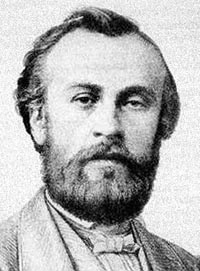Henri Giffard
Henri Giffard | |
|---|---|
 | |
| Born | Baptiste Jules Henri Jacques Giffard (1825-02-08)8 February 1825 Paris, France |
| Died | 14 April 1882(1882-04-14) (aged 57)[1] |
| Nationality | French |
| Occupation | engineer |
| Known for | steam injector, Giffard dirigible airship |


Baptiste Jules Henri Jacques Giffard (8 February 1825 – 14 April 1882) was a French engineer. In 1852 he invented the steam injector and the powered Giffard dirigible airship.
Career
Giffard was born in Paris in 1825. He invented the injector and the Giffard dirigible, an airship powered with a steam engine and weighing over 180 kilograms (400 lb). It was the world's first passenger-carrying airship (then known as a dirigible, from French).[2] Both practical and steerable, the hydrogen-filled airship was equipped with a 2.2-kilowatt (3 hp) steam engine that drove a propeller. The engine was fitted with a downward-pointing funnel. The exhaust steam was mixed in with the combustion gases and it was hoped by these means to stop sparks rising up to the gas bag; he also installed a vertical rudder.[citation needed]
On 24 September 1852, Giffard made the first powered and controlled flight travelling 27 kilometres (17 mi) from Paris to Élancourt.[3] The wind was too strong to allow him to make way against it, so he was unable to return to the start.[3] However, he was able to make turns and circles,[citation needed] proving that a powered airship could be steered and controlled.[4]
Giffard was granted a patent for the injector on 8 May 1858. Unusually, he had thoroughly worked out the theory of this invention before making any experimental instrument, having explained the idea in 1850. Others had worked on using jets, particularly Eugène Bourdon who patented a very similar device in 1857.[5]
In 1863, he was appointed a Chevalier of the Légion d'honneur.[6]
Death and commemoration
In response to his declining eyesight, Giffard committed suicide in 1882,[6] leaving his estate to the nation for humanitarian and scientific purposes.[7]
Gallery
-
![Balloon of Henri Giffard over Paris rooftops, 1878.[8][9]](//upload.wikimedia.org/wikipedia/commons/thumb/d/da/Captive_balloon_of_Henri_Giffard_over_Paris_1878.jpg/120px-Captive_balloon_of_Henri_Giffard_over_Paris_1878.jpg)
- A model of the Giffard Airship at the London Science Museum.
-
![Medal of Giffard's balloon over Paris in 1878.[8]](//upload.wikimedia.org/wikipedia/commons/thumb/7/7c/Ballooning_Bronze_Medal_Paris_1878_Giffard..jpg/120px-Ballooning_Bronze_Medal_Paris_1878_Giffard..jpg) Medal of Giffard's balloon over Paris in 1878.[8]
Medal of Giffard's balloon over Paris in 1878.[8]
See also
- List of firsts in aviation
- Alberto Santos-Dumont
References
- ^ "Our Paris Letter". The Bunyip. No. 895. South Australia. 16 June 1882. p. 4. Retrieved 17 March 2019 – via National Library of Australia., ...The death is announced of M. Henry Giffard, the engineer, tendered celebrated by the invention of the ' Injecteur Giffard.' He paid considerable attention formerly to aeronoutic science, and' established the captive balloons at the Exhibitions of 1866 and 1868. In 1857 he obtained the Mechanical prize of the Academy of Sciences for the discoverg of the injector, and was made a member of the Legion in 1863...
- ^ Jules Henri Giffard, retrieved 9 May 2009
- ^ a b Science Museum - Home - The Giffard Airship, 1852., Science Museum, archived from the original on 6 April 2012, retrieved 9 May 2009
- ^ Tissandier, Gaston (1872), Les ballons dirigeables : experiences de m. Henri Giffard en 1852 et en 1855 et de m. Dupuy de Lome en 1872, E. Dentu, retrieved 17 March 2019
- ^ Kneass, Strickland L. (2004) [1894], Practice and Theory of the Injector, New York: Wiley, ISBN 1-55918-306-3
- ^ a b Day, Lance; McNeil, Ian (1996), "Giffard, Baptiste Henri Jacques (Henri)", Biographical Dictionary of the History of Technology, Taylor & Francis, pp. 285–286, ISBN 978-0-415-06042-4, retrieved 24 June 2009
- ^ "Science. Scientific Gossip". Leader. Vol. XLVI, no. 1417. Victoria, Australia. 17 February 1883. p. 8. Retrieved 17 March 2019 – via National Library of Australia., ...Henri Giffard, who bequeathed his large fortune for the endowment of scientific research...
- ^ a b Grand ballon captif a vapeur, de M. Henry Giffard [text], Typographie P. Mouillot, 1878, retrieved 17 March 2019, ...Blank form for passengers to record "observations" (data) during ascents in Giffard's giant captive balloon from the Tuileries courtyard in the Paris Exposition of 1878...
- ^ "A MONSTER BALLOON". Adelaide Observer. Vol. XXXIII, no. 1838. South Australia. 23 December 1876. p. 20. Retrieved 17 March 2019 – via National Library of Australia.
Bibliography
- Fonvielle, W. de (Wilfrid) (1885), Conférence sur les travaux aéronautiques de Henry Giffard, Imp. Collombon et Brûlé, retrieved 17 March 2019
- Tissandier, Gaston; Tissandier, Albert, 1839-1906, (illus.) (1879), Le grand ballon captif à vapeur de M. Henry Giffard. : Cour des Tuileries--1878-1879 (3. éd ed.), G. Masson, retrieved 17 March 2019
{{citation}}: CS1 maint: multiple names: authors list (link) CS1 maint: numeric names: authors list (link) - Giffard, Henri, Henri Giffard papers, 1852-1910, retrieved 17 March 2019, ...Correspondence, notes, design drawings, broadsides, newspapers, printed illustrations, articles about Giffard, and newspaper clippings relating chiefly to Giffard's exhibition of a large captive balloon in the courtyard of the Tuileries in Paris in 1878. Includes his notes on hydrogen gas and design drawings for balloons...
External links

- Who Was the First Person to Fly? at the Wayback Machine (archived 5 March 2008) - discusses Henri Giffard's first powered flight, LiveScience.com, 4 March 2008
![Balloon of Henri Giffard over Paris rooftops, 1878.[8][9]](http://upload.wikimedia.org/wikipedia/commons/thumb/d/da/Captive_balloon_of_Henri_Giffard_over_Paris_1878.jpg/120px-Captive_balloon_of_Henri_Giffard_over_Paris_1878.jpg)

![Medal of Giffard's balloon over Paris in 1878.[8]](http://upload.wikimedia.org/wikipedia/commons/thumb/7/7c/Ballooning_Bronze_Medal_Paris_1878_Giffard..jpg/120px-Ballooning_Bronze_Medal_Paris_1878_Giffard..jpg)










